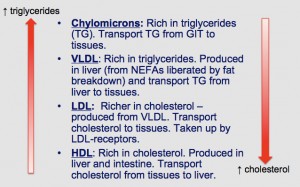The major lipoprotein classes are the triglyceride-rich chylomicrons (CM) and very low density lipoproteins (VLDL) and the more cholesterol-rich low density lipoproteins (LDL) and high density lipoproteins (HDL). Increases in CM and VLDL are associated with visible lipemia, with CM forming a fat layer and VLDL forming a cloudy infranatant. Increases in LDL and HDL alone do not result in visible lipemia.
CM are packaged from dietary lipids and originate from the gastrointestinal tract. They are used to deliver triglycerides to tissues for use. If in excess to energy needs, they are broken down and stored as fat in adipose tissue.
VLDL are packaged in the liver and are produced from NEFA due to fat breakdown (state of lipolysis) during states of negative energy balance. They take triglycerides to tissues for use (e.g. energy)
LDL are created by lipoprotein lipase on endothelial cells and are the main source of cholesterol for tissues.
HDL are produced in the liver and intestine and are involved in “reverse” cholesterol transport (they deliver cholesterol from tissues back to the liver).

